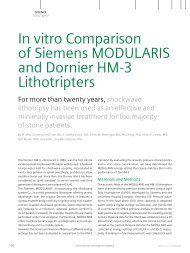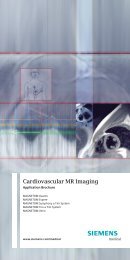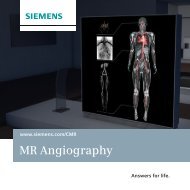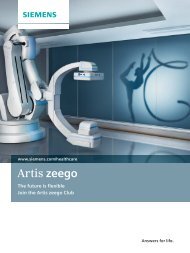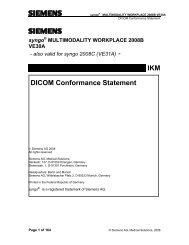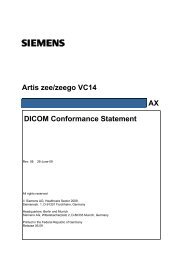Advances in Acridinium Ester Technology - Siemens Healthcare
Advances in Acridinium Ester Technology - Siemens Healthcare
Advances in Acridinium Ester Technology - Siemens Healthcare
You also want an ePaper? Increase the reach of your titles
YUMPU automatically turns print PDFs into web optimized ePapers that Google loves.
<strong>Siemens</strong> <strong>Healthcare</strong> Diagnostics, a global leader<br />
<strong>in</strong> cl<strong>in</strong>ical diagnostics, provides healthcare<br />
professionals <strong>in</strong> hospital, reference, and<br />
physician office laboratories and po<strong>in</strong>t-of-care<br />
sett<strong>in</strong>gs with the vital <strong>in</strong>formation required<br />
to accurately diagnose, treat, and monitor<br />
patients. Our <strong>in</strong>novative portfolio of<br />
performance-driven solutions and personalized<br />
customer care comb<strong>in</strong>e to streaml<strong>in</strong>e<br />
workflow, enhance operational efficiency,<br />
and support improved patient outcomes.<br />
ADVIA Centaur and all associated marks<br />
are trademarks of <strong>Siemens</strong> <strong>Healthcare</strong><br />
Diagnostics Inc. All other trademarks and<br />
brands are the property of their respective<br />
owners. Product availability may vary from<br />
country to country and is subject to vary<strong>in</strong>g<br />
regulatory requirements. Please contact<br />
your local representative for availability.<br />
Order No. A91DX-CAI-120235-GC1-4A00<br />
10-2012 | All rights reserved<br />
© 2012 <strong>Siemens</strong> <strong>Healthcare</strong> Diagnostics Inc.<br />
White Paper<br />
Global <strong>Siemens</strong> Headquarters<br />
<strong>Siemens</strong> AG<br />
Wittelsbacherplatz 2<br />
80333 Muenchen<br />
Germany<br />
Global <strong>Siemens</strong> <strong>Healthcare</strong><br />
Headquarters<br />
<strong>Siemens</strong> AG<br />
<strong>Healthcare</strong> Sector<br />
Henkestrasse 127<br />
91052 Erlangen<br />
Telephone: +49 9131 84-0<br />
Germany<br />
www.siemens.com/healthcare<br />
Global Division<br />
<strong>Siemens</strong> <strong>Healthcare</strong> Diagnostics Inc.<br />
511 Benedict Avenue<br />
Tarrytown, NY 10591-5005<br />
USA<br />
www.siemens.com/diagnostics<br />
Meet<strong>in</strong>g Evolv<strong>in</strong>g Cl<strong>in</strong>ical Demands<br />
for Assay Performance: <strong>Advances</strong><br />
<strong>in</strong> Acrid<strong>in</strong>ium <strong>Ester</strong> <strong>Technology</strong> on<br />
the ADVIA Centaur Systems<br />
Authors: Anand Natrajan, PhD and Q<strong>in</strong>gp<strong>in</strong>g Jiang, PhD<br />
<strong>Siemens</strong> <strong>Healthcare</strong> Diagnostics, Advanced <strong>Technology</strong> and Pre-Development<br />
www.siemens.com/diagnostics<br />
Answers for life.
Driv<strong>in</strong>g Innovation <strong>in</strong> Chemilum<strong>in</strong>escent Immunoassay<br />
Design with Evolv<strong>in</strong>g Acrid<strong>in</strong>ium <strong>Ester</strong> <strong>Technology</strong><br />
Background<br />
The cont<strong>in</strong>uous evolution of acrid<strong>in</strong>ium ester (AE)<br />
chemilum<strong>in</strong>escence technology by <strong>Siemens</strong> <strong>Healthcare</strong><br />
Diagnostics, and its applications <strong>in</strong> immunoassay test<strong>in</strong>g,<br />
is a success story. The story bears comparison to the<br />
evolution of the microprocessor, whose development over<br />
the years has <strong>in</strong>creased the power and utility of desktop<br />
and laptop computers. Likewise, advances <strong>in</strong> AE<br />
technology have resulted <strong>in</strong> significant improvements <strong>in</strong><br />
the performance and reliability of commonly used cl<strong>in</strong>ical<br />
assays. Microprocessor evolution has also helped drive<br />
the <strong>in</strong>troduction of novel forms of personal comput<strong>in</strong>g,<br />
such as tablet devices and smartphones. Similarly,<br />
<strong>Siemens</strong> evolution of the AE molecule supports the<br />
<strong>in</strong>troduction of new assays, <strong>in</strong>clud<strong>in</strong>g:<br />
• A Thyroid-Stimulat<strong>in</strong>g Hormone assay (TSH3-Ultra) that<br />
delivers enhanced low-end precision and sensitivity<br />
• An assay for cardiac tropon<strong>in</strong> I (TnI-Ultra) that improves<br />
analytical sensitivity by a factor of 5 over its predecessor<br />
• The Enhanced Liver Fibrosis (ELF)* test, the first fully<br />
automated liver fibrosis test that detects the direct<br />
biomarkers of liver fibrosis<br />
• An assay for Vitam<strong>in</strong> D Total that demonstrates good<br />
cl<strong>in</strong>ical concordance with LC/MS/MS methods<br />
Chemilum<strong>in</strong>escence has been a lead<strong>in</strong>g technology of<br />
choice for multiple diagnostics vendors, and is likely<br />
to rema<strong>in</strong> so as new immunoassay systems emerge.<br />
<strong>Siemens</strong> ADVIA Centaur® Immunoassay Systems utilize AE<br />
chemilum<strong>in</strong>escence technology because of its flexibility<br />
and ability for optimization.<br />
In this paper, we review cl<strong>in</strong>ical and other benefits<br />
delivered by some of the latest AE-dependent assays<br />
from <strong>Siemens</strong>. The history of acrid<strong>in</strong>ium ester molecule<br />
evolution, review<strong>in</strong>g specific details of AE properties,<br />
ongo<strong>in</strong>g research f<strong>in</strong>d<strong>in</strong>gs, and modifications to the<br />
AE molecule that cont<strong>in</strong>ue to drive critical advances<br />
<strong>in</strong> assay performance and diagnostic test<strong>in</strong>g are<br />
also detailed.<br />
Introduction<br />
Immunoassay technology is <strong>in</strong> a state of constant<br />
development, driven by novel marker discovery, and<br />
cl<strong>in</strong>ical demands for greater assay sensitivity, specificity,<br />
and precision. The AE chemilum<strong>in</strong>escence technology<br />
featured on ADVIA Centaur Immunoassay Systems<br />
has successfully resolved many of these challenges and is<br />
push<strong>in</strong>g the <strong>in</strong>novation barrier through the <strong>in</strong>nate<br />
characteristics of the AE molecule. The AE molecule is<br />
extremely flexible because it is based on a family of<br />
chemilum<strong>in</strong>escent structures that can be selectively<br />
optimized for each <strong>in</strong>dividual assay.<br />
Sidebar A: Features of evolv<strong>in</strong>g<br />
acrid<strong>in</strong>ium ester chemistry<br />
High quantum yield (HQY). High signal-to-noise<br />
ratio for improved sensitivity and low-end precision.<br />
Hydrophilicity. Improved efficacy of wash step<br />
for low nonspecific b<strong>in</strong>d<strong>in</strong>g.<br />
Hydrolytic stability. Long reagent shelf life and<br />
extended onboard stability.<br />
Versatility. Label<strong>in</strong>g versatility for an extensive<br />
assay menu.<br />
Small size. Direct label<strong>in</strong>g with AE for use <strong>in</strong> a<br />
broad range of assays.<br />
Rapid k<strong>in</strong>etics. Light emission complete <strong>in</strong><br />
1 to 5 seconds for high throughput.<br />
Ongo<strong>in</strong>g modification of the AE technology used on<br />
ADVIA Centaur Systems cont<strong>in</strong>ues to meet the grow<strong>in</strong>g<br />
needs for improved detection. The latest developments <strong>in</strong><br />
<strong>Siemens</strong> AE chemistry have established the groundwork<br />
for assays with even better low-end precision and<br />
sensitivity, and for other significant assay improvements,<br />
<strong>in</strong>clud<strong>in</strong>g enhanced reagent stability, higher throughput,<br />
and smaller sample volumes (see Sidebar A). AE molecule<br />
evolution is also enabl<strong>in</strong>g the <strong>in</strong>troduction of novel<br />
assays, and is facilitat<strong>in</strong>g their design through reliance<br />
on well-proven pr<strong>in</strong>ciples and performance.<br />
ADVIA Centaur TSH3-Ultra Assay:<br />
A Step-Change <strong>in</strong> Low-End Precision<br />
Unlike the latest ADVIA Centaur TSH3-Ultra assay, some<br />
of the older or alternative chemilum<strong>in</strong>escent technologies<br />
cannot provide the cl<strong>in</strong>ical performance currently required<br />
for accurate low level assessment of TSH levels. Low-end<br />
precision <strong>in</strong> a Thyroid-Stimulat<strong>in</strong>g Hormone (TSH) assay<br />
is also important to optimal management of patients with<br />
thyroid disease.<br />
The <strong>Siemens</strong> TSH3-Ultra assay is based on a re-eng<strong>in</strong>eered<br />
AE molecule that shows both greater quantum yield<br />
and greater hydrophilicity than the AE variant used by<br />
its predecessor. Even though the older TSH3 assay<br />
demonstrated third-generation performance, the<br />
newer TSH3-Ultra assay delivers significantly improved<br />
low-end precision and sensitivity, as well as reduced<br />
sample size.<br />
This was confirmed <strong>in</strong> a performance comparison study<br />
between the TSH3-Ultra assay and the TSH3 assay.<br />
Figure 1 shows the precision profiles used to determ<strong>in</strong>e<br />
each assay’s functional sensitivity.<br />
• TSH3-Ultra assay low-end precision is nearly an order<br />
of magnitude better: The profile shows significantly<br />
improved low-end precision across the entire<br />
concentration <strong>in</strong>terval tested (CV improvement by a<br />
factor of approximately 2).<br />
• The profile for the TSH3-Ultra assay shows a shift to<br />
the left correspond<strong>in</strong>g to a 3-fold improvement <strong>in</strong><br />
functional sensitivity, from approximately 0.018 mIU/L<br />
down to 0.008 mIU/L (functional sensitivity for TSH<br />
assays is def<strong>in</strong>ed as the lowest concentration with<br />
a total CV of 20% or better).<br />
• The TSH3-Ultra assay also decreases the sample size<br />
required from 200 μL to 100 μL.<br />
Figure 1. Precision profiles for the TSH3-Ultra assay and its<br />
predecessor. The curves depict total CVs (with<strong>in</strong>-laboratory)<br />
as a function of TSH concentration.<br />
Total CV (%)<br />
60<br />
50<br />
40<br />
30<br />
20<br />
10<br />
0<br />
0.000<br />
TSH-ultra<br />
TSH3<br />
0.010 0.020 0.030 0.040 0.050 0.060 0.070 0.080 0.090 0.100 0.110<br />
Concentration (mlU/L)<br />
ADVIA Centaur TnI-Ultra Assay:<br />
Five Times More Sensitive than its Predecessor<br />
Cardiac tropon<strong>in</strong> I measurements determ<strong>in</strong>ed by highsensitivity<br />
assays may be used as an aid <strong>in</strong> the diagnosis<br />
of acute myocardial <strong>in</strong>farction (AMI), and <strong>in</strong> the risk<br />
stratification of patients with acute coronary syndromes.<br />
The AE-based ADVIA Centaur TnI-Ultra assay is a highly<br />
precise assay that can measure very low concentrations of<br />
cardiac tropon<strong>in</strong> I. This excellent precision exceeds the<br />
<strong>in</strong>dustry benchmark established by the Jo<strong>in</strong>t European<br />
Society of Cardiology/American College of Cardiology<br />
Committee of ≤10% CV at the 99th percentile of normal.<br />
The assay uses the HQYAE molecule (Table 1) to help<br />
improve analytical sensitivity by a factor of 5 over<br />
the previous ADVIA Centaur cTnI assay.<br />
Table 1. Analytical values of the Tnl-Ultra assay versus its predecessor.<br />
Values<br />
ADVIA Centaur<br />
TnI-Ultra Assay<br />
ADVIA Centaur<br />
cTnI Assay<br />
10% CV 0.03 ng/mL 0.33 ng/mL<br />
99th<br />
Percentile<br />
Analytical<br />
Sensitivity<br />
0.04 ng/mL 0.07 ng/mL<br />
0.006 ng/mL 0.03 ng/mL<br />
Improvement<br />
Ten-fold<br />
improvement<br />
<strong>in</strong> precision<br />
Nearly 50%<br />
lower values<br />
Five times more<br />
sensitive<br />
ADVIA Centaur ELF Test: Sett<strong>in</strong>g a New<br />
Standard <strong>in</strong> Liver Fibrosis Assessment<br />
<strong>Siemens</strong> AE-related research has helped <strong>in</strong> the<br />
development of the <strong>in</strong>novative Enhanced Liver Fibrosis<br />
(ELF) test that measures direct biomarkers of liver<br />
fibrosis to assess the severity of liver fibrosis <strong>in</strong> patients<br />
with chronic liver disease.<br />
The current standard of care to assess liver fibrosis is an<br />
<strong>in</strong>vasive liver biopsy. However, numerous problems<br />
with obta<strong>in</strong><strong>in</strong>g and <strong>in</strong>terpret<strong>in</strong>g liver biopsies have fueled<br />
the search for additional and less <strong>in</strong>vasive methods for<br />
assess<strong>in</strong>g the severity of liver fibrosis.<br />
The ELF* test is the first standardized rout<strong>in</strong>e test to use<br />
a blood-serum sample to help assess the severity of liver<br />
fibrosis <strong>in</strong> patients with chronic liver disease. The test<br />
comb<strong>in</strong>es three direct serum biomarkers to obta<strong>in</strong> a s<strong>in</strong>gle<br />
ELF score calculated by ADVIA Centaur Systems that<br />
correlates with severity of fibrosis as assessed by liver<br />
biopsy. The test has been cl<strong>in</strong>ically validated <strong>in</strong> an<br />
<strong>in</strong>ternational multi-center study with a mix of patient<br />
groups, and was found to be accurate <strong>in</strong> differentiat<strong>in</strong>g<br />
mild, moderate, and severe fibrosis.<br />
* Not available for sale <strong>in</strong> the U.S. * Not available for sale <strong>in</strong> the U.S.<br />
2 3
ADVIA Centaur Vitam<strong>in</strong> D Total Assay:<br />
Fast, Accurate Vitam<strong>in</strong> D Results<br />
on a Primary Analyzer<br />
A modified AE molecule (ZAE, Figure 6) is a central<br />
component of the <strong>Siemens</strong> Vitam<strong>in</strong> D Total assay,<br />
which offers the equimolar detection of both D2 and D3<br />
necessary for assessment of vitam<strong>in</strong> D status. In recent<br />
years, vitam<strong>in</strong> D has become an assay of general health<br />
status, and multiple publications have l<strong>in</strong>ked vitam<strong>in</strong> D<br />
deficiency to several disease states, such as cancer,<br />
cardiovascular disease, diabetes, and autoimmune diseases.<br />
The AE-reliant ADVIA Centaur Systems Vitam<strong>in</strong> D Total<br />
assay elim<strong>in</strong>ates the need for a specialty analyzer for<br />
vitam<strong>in</strong> D test<strong>in</strong>g. The assay measures total 25(OH)<br />
Vitam<strong>in</strong> D with equimolarity (~100 D2 and D3) to ensure<br />
accurate results with good precision, and offers cl<strong>in</strong>ical<br />
concordance with LC/MS/MS methods. Results are<br />
available <strong>in</strong> 18 m<strong>in</strong>utes, represent<strong>in</strong>g a significant<br />
improvement <strong>in</strong> turnaround time over legacy methods.<br />
A History of AE Molecule Evolution<br />
When automated non-isotopic technologies began to<br />
displace 125I-labeled radioimmunoassays (RIA) and other<br />
immunoradiometric assays <strong>in</strong> the cl<strong>in</strong>ical laboratory,<br />
chemilum<strong>in</strong>escence based on direct label<strong>in</strong>g with AE<br />
played a prom<strong>in</strong>ent role because of the advantages<br />
offered by the AE molecule (see Sidebar A). In particular,<br />
AE’s small size enables its use <strong>in</strong> a broad range of assays<br />
and contributes to the generation of high quantum yields.<br />
This enables highly sensitive detection with performance<br />
similar or superior to RIA while elim<strong>in</strong>at<strong>in</strong>g many of<br />
the problems of work<strong>in</strong>g with radioactive isotopes.<br />
<strong>Advances</strong> <strong>in</strong> AE-based chemilum<strong>in</strong>escence technology<br />
encompass an impressive legacy of contemporary and<br />
historical research. Discoveries made <strong>in</strong> the research<br />
environment have led to an understand<strong>in</strong>g of how to<br />
modify the AE structure for enhanced quantum<br />
yield, hydrophilicity, hydrolytic stability, emission k<strong>in</strong>etics,<br />
and flexibility <strong>in</strong> assay design. These modifications<br />
to AE technology <strong>in</strong>clude better sensitivity and low-end<br />
precision, more diverse assay architectures, faster<br />
throughput, smaller sample volumes, enhanced onboard<br />
reagent stability, longer shelf life, and overall greater<br />
assay robustness.<br />
The chemical versatility of the AE molecules have been<br />
vital <strong>in</strong> allow<strong>in</strong>g improvement of exist<strong>in</strong>g assays as well<br />
as development of novel test<strong>in</strong>g advances. Moreover,<br />
improved methods for synthesiz<strong>in</strong>g the AE molecules and<br />
optimiz<strong>in</strong>g the conditions under which they react and<br />
emit light have been developed. Many of these AE-related<br />
advances are detailed <strong>in</strong> some 40 issued and pend<strong>in</strong>g U.S.<br />
patents, as well as <strong>in</strong> numerous peer-reviewed journal<br />
articles (see Reference List).<br />
AE Properties and Assay Design<br />
AE-based assays have a proven record of performance<br />
that can be directly related back to unique properties<br />
<strong>in</strong>herent to the analog of AE used. Five pr<strong>in</strong>cipal<br />
AE forms are shown <strong>in</strong> Figures 2 through 6. Internal<br />
differences among these five molecular forms<br />
contribute towards better assay performance and fall<br />
<strong>in</strong>to two categories:<br />
Sensitivity: Improvements <strong>in</strong> low-end precision and<br />
sensitivity are relevant to assays for analytes such as<br />
thyrotrop<strong>in</strong> (TSH) and tropon<strong>in</strong> I (TnI) that are central<br />
to thyroid and cardiovascular disease test<strong>in</strong>g.<br />
Robustness: Relevant for all analytes are improvements<br />
<strong>in</strong> reagent stability, aqueous solubility (hydrophilicity),<br />
lower non-specific b<strong>in</strong>d<strong>in</strong>g, and lot-to-lot consistency.<br />
Direct label<strong>in</strong>g with a small chemilum<strong>in</strong>escent molecule is<br />
preferable to us<strong>in</strong>g a larger enzyme, as is done <strong>in</strong> many<br />
other non-isotopic immunoassay systems. In terms of<br />
molecular weight, the size of an AE is only slightly larger<br />
than 125I, whereas enzymes can be several hundred<br />
times larger; even a small enzyme like horseradish<br />
peroxidase (HRP) is larger by a factor of up to 120<br />
compared to dimethyl AE (DMAE). This is especially critical<br />
for competitive immunoassay formats, where direct<br />
label<strong>in</strong>g with AE makes it possible for the labeled analyte<br />
to compete with the analyte from the patient sample for<br />
antibody sites on an equal basis. Moreover, conjugate<br />
preparation and analyte label<strong>in</strong>g are simpler and more<br />
straightforward when work<strong>in</strong>g with AEs.<br />
The orig<strong>in</strong>al AE molecule developed by <strong>Siemens</strong><br />
<strong>Healthcare</strong> Diagnostics, dimethyl AE (DMAE), is shown <strong>in</strong><br />
Figure 2. It is composed of three parts: a tricyclic<br />
acrid<strong>in</strong>ium r<strong>in</strong>g system (<strong>in</strong> black), a dimethylphenolic<br />
ester (lavender), and an N-hydroxysucc<strong>in</strong>imidyl (NHS)<br />
ester (green). The acrid<strong>in</strong>ium r<strong>in</strong>g, with its quaternary<br />
nitrogen, is responsible for the chemilum<strong>in</strong>escence<br />
reaction. Conjugation is effected through the NHS ester.<br />
The two methyl groups flank<strong>in</strong>g the phenolic ester<br />
provide steric shield<strong>in</strong>g and thus greatly enhanced<br />
chemilum<strong>in</strong>escent stability.<br />
Figure 2. “DMAE,” 1989. DMAE-NHS. <strong>Siemens</strong> orig<strong>in</strong>al dimethyl<br />
acrid<strong>in</strong>ium ester. The tricyclic acrid<strong>in</strong>ium r<strong>in</strong>g system is<br />
<strong>in</strong>dicated <strong>in</strong> black, the dimethylphenolic ester <strong>in</strong> lavender,<br />
and the N-hydroxysucc<strong>in</strong>imidyl (NHS) ester <strong>in</strong> green.<br />
site for reaction<br />
with peroxide<br />
Me<br />
+ N<br />
O<br />
phenolic ester<br />
O<br />
O<br />
Methyl group on<br />
quaternary nitrogen<br />
O<br />
O<br />
N<br />
O<br />
NHS ester<br />
for conjugation<br />
The light-emitt<strong>in</strong>g reaction for an AE molecule is both<br />
less complex and more efficient than that of other<br />
chemilum<strong>in</strong>escent structures, for example, lum<strong>in</strong>ol and<br />
its derivatives, which require catalysts and suffer from<br />
impaired light emission when coupled to a biomolecule.<br />
Expos<strong>in</strong>g the AE to an alkal<strong>in</strong>e H 2<br />
O 2<br />
(hydrogen peroxide)<br />
solution triggers a flash. Before the flash occurs,<br />
the acridone, which is the light emitt<strong>in</strong>g species,<br />
separates from the rema<strong>in</strong>der of the conjugate, so the<br />
subsequent light emission is not <strong>in</strong>fluenced by the<br />
size or structure of the particular antigen or antibody<br />
attached to the phenol group. 6 The event emits light at a<br />
wavelength maximum, depend<strong>in</strong>g on the specific AE variant,<br />
<strong>in</strong> the range of 430 to 480 nm, a range well suited for the<br />
high-efficiency photomultiplier tubes (PMTs) used<br />
<strong>in</strong> the ADVIA Centaur Systems. Furthermore, because<br />
the light emission is rapid and completes with<strong>in</strong> 1 to 5<br />
seconds, precise PMT-based measurement of the<br />
output can be achieved <strong>in</strong> a short time with a high<br />
signal-to-noise ratio, without los<strong>in</strong>g <strong>in</strong>formation<br />
from the light emitted and without <strong>in</strong>terference from<br />
the accumulation of background emission.<br />
These properties are important characteristics for a<br />
chemilum<strong>in</strong>escent system. Because of their small size and<br />
chemical properties, direct label<strong>in</strong>g with AE molecules<br />
is a simple, <strong>in</strong>herently reliable approach, versatile enough<br />
to accommodate the wide range of analytes appropriate<br />
for measurement or detection by immunoassay, and<br />
support<strong>in</strong>g requirements for rapid turnaround and high<br />
throughput. AE molecules can be used to label small<br />
haptens, large analytes, and antibodies, allow<strong>in</strong>g for a very<br />
broad menu of assays shar<strong>in</strong>g a common signal<strong>in</strong>g system.<br />
Early Improvements<br />
The orig<strong>in</strong>al <strong>Siemens</strong> AE molecule was made viable as an<br />
assay technology by the discovery that fortify<strong>in</strong>g the<br />
phenol r<strong>in</strong>g with a pair of methyl groups (highlighted <strong>in</strong><br />
Figure 2) would protect the conjugates from hydrolysis<br />
at the bond between the acrid<strong>in</strong>ium r<strong>in</strong>g and the phenol,<br />
result<strong>in</strong>g <strong>in</strong> excellent shelf life and onboard reagent<br />
stability. 7 To measure the improved hydrolytic stability<br />
yielded by this modification, experiments showed<br />
essentially no loss of chemilum<strong>in</strong>escent activity at<br />
37°C over the course of a week for the dimethyl AE<br />
(DMAE, Figure 2), compared to a 90% loss under<br />
the same conditions for the unshielded AE.<br />
The first improvement to the orig<strong>in</strong>al molecule <strong>in</strong>volved<br />
attach<strong>in</strong>g an N-sulfopropyl (NSP) group to the nitrogen <strong>in</strong><br />
the acrid<strong>in</strong>ium r<strong>in</strong>g <strong>in</strong> place of the DMAE methyl group<br />
(Figure 3, <strong>in</strong> blue).<br />
Figure 3. NSP-DMAE-NHS, 1997. The newly added N-sulfopropyl<br />
(NSP) group is highlighted <strong>in</strong> blue.<br />
O<br />
+<br />
N<br />
O<br />
O<br />
O<br />
SO 3<br />
-<br />
N<br />
O<br />
O<br />
The second and third versions of the AE are shown <strong>in</strong><br />
Figures 3 and 4. They represent successive improvements<br />
<strong>in</strong> the hydrophilicity (aqueous solubility) of the conjugates<br />
[Pat97, Pat03]. In particular, greater hydrophilicity and<br />
electrical neutrality can produce lower nonspecific b<strong>in</strong>d<strong>in</strong>g<br />
and an improved signal-to-noise ratio. Such characteristics<br />
are conferred by functional groups such as hexa(ethylene)<br />
glycol (HEG) or N-sulfopropyl group.<br />
Neither of these improvements sacrificed hydrolytic<br />
stability or other desirable characteristics (<strong>in</strong>clud<strong>in</strong>g<br />
k<strong>in</strong>etics and wavelength) of the orig<strong>in</strong>al DMAE (Figure 2).<br />
In addition to enhanced hydrophilicity, these 1997<br />
and 2003 variants both exhibit about 50% better<br />
quantum yield (higher total light emission) than the<br />
orig<strong>in</strong>al DMAE. Increased light output comb<strong>in</strong>ed with<br />
reduced non-specific b<strong>in</strong>d<strong>in</strong>g translates <strong>in</strong>to improved<br />
low-end precision and sensitivity by further enhanc<strong>in</strong>g<br />
the signal-to-noise ratio. The HEGAE variant (Figure 4)<br />
was one of the <strong>in</strong>novations <strong>in</strong>troduced <strong>in</strong>to the<br />
ADVIA Centaur TSH3-Ultra assay, whose superior<br />
performance characteristics are partly the result<br />
of the <strong>in</strong>creased quantum yield and hydrophilicity<br />
of its chemilum<strong>in</strong>escent technology.<br />
Figure 4. “HEGAE,” 2003. NSP-DMAE-HEG-NHS.<br />
The <strong>in</strong>serted HEG l<strong>in</strong>ker is shown <strong>in</strong> red.<br />
O<br />
+<br />
N<br />
O<br />
O<br />
N<br />
H<br />
SO 3<br />
-<br />
O<br />
5<br />
N<br />
H<br />
O<br />
O<br />
O<br />
N<br />
O<br />
O<br />
dimethyl groups<br />
for ester stability<br />
4 5
The search for better techniques of synthesiz<strong>in</strong>g the NSP<br />
variants shown <strong>in</strong> Figures 3 and 4 resulted <strong>in</strong> a versatile,<br />
highly robust manufactur<strong>in</strong>g process, with considerably<br />
higher yields and greatly improved reproducibility. Details<br />
of the method are described <strong>in</strong> an article by Natrajan<br />
et al., published <strong>in</strong> Green Chemistry <strong>in</strong> 2011. 12 This<br />
enhanced manufactur<strong>in</strong>g technique virtually elim<strong>in</strong>ates<br />
a potential source of lot-to-lot variation associated with<br />
chemilum<strong>in</strong>escent technologies. It is also <strong>in</strong>herently<br />
“greener.” The new process reduces usage of propane<br />
sultone needed for synthesis of acrid<strong>in</strong>ium esters,<br />
m<strong>in</strong>imiz<strong>in</strong>g potential exposure to personnel, and<br />
reduc<strong>in</strong>g toxic waste.<br />
Cont<strong>in</strong>u<strong>in</strong>g Innovation<br />
Figure 5 shows a still more recent structure featur<strong>in</strong>g<br />
a pair of methoxyhexa(ethylene)glycol ethers (<strong>in</strong> red)<br />
attached to the outer r<strong>in</strong>gs of the acrid<strong>in</strong>ium r<strong>in</strong>g. 10,11<br />
Figure 5. “HQYAE” (High Quantum Yield Acrid<strong>in</strong>ium <strong>Ester</strong>),<br />
2007 and 2010. The methoxyhexa(ethylene)glycol ethers at C2<br />
and C7 are shown <strong>in</strong> red.<br />
SO 3<br />
-<br />
H 3<br />
CO<br />
O<br />
O<br />
5<br />
O<br />
+<br />
N<br />
O<br />
O<br />
This analog is called “high quantum yield” AE (HQYAE)<br />
because its light output is approximately 3 times<br />
that of the earlier NSP variants (Figures 3 and 4) and<br />
more than 4 times that of the orig<strong>in</strong>al DMAE (Figure 2).<br />
The patented HQYAE variant is also more hydrophilic<br />
than its predecessors.<br />
The alkoxy groups <strong>in</strong>troduced at the C2 and C7 positions<br />
on the acrid<strong>in</strong>ium r<strong>in</strong>g structure are responsible for the<br />
<strong>in</strong>creased quantum yield, enhanced aqueous solubility,<br />
and lower nonspecific b<strong>in</strong>d<strong>in</strong>g.<br />
N<br />
H<br />
O<br />
O<br />
5<br />
O<br />
O<br />
OCH 3<br />
O<br />
N<br />
O<br />
With both <strong>in</strong>creased light emission and decreased nonspecific<br />
b<strong>in</strong>d<strong>in</strong>g, it is expected that the HQYAE will have a<br />
considerably better signal-to-noise ratio, and assays based<br />
on the newer structure should show improved low-end<br />
precision. As an example, the ADVIA Centaur TnI-Ultra<br />
assay which uses the HQYAE variant shows analytical<br />
sensitivity improved by a factor of 5, from 0.03 ng/mL<br />
to 0.006 ng/mL us<strong>in</strong>g HQYAE.<br />
HQYAE is also available for use <strong>in</strong> other assays where<br />
low-end sensitivity is essential, or where the <strong>in</strong>herent<br />
<strong>in</strong>solubility of the analyte might be an issue, such as the<br />
immunosuppressant cyclospor<strong>in</strong>e.<br />
Development of HQYAE, detailed <strong>in</strong>vestigation of its<br />
properties, and its subsequent <strong>in</strong>corporation <strong>in</strong>to assays,<br />
represents major progress <strong>in</strong> the ongo<strong>in</strong>g effort to<br />
cont<strong>in</strong>uously improve the direct-label<strong>in</strong>g AE technology<br />
used on the ADVIA Centaur systems.<br />
Other AE-related developments <strong>in</strong>clude complementary<br />
approaches to improv<strong>in</strong>g solubility and limit<strong>in</strong>g nonspecific<br />
b<strong>in</strong>d<strong>in</strong>g. A recently published study explored the<br />
impact of various surfactants on the k<strong>in</strong>etics and total<br />
light emission of AE variants. 13 The study resulted <strong>in</strong> a<br />
deeper understand<strong>in</strong>g of the mechanisms <strong>in</strong>volved, and<br />
led to discovery of promis<strong>in</strong>g alternative methods for<br />
improv<strong>in</strong>g aqueous solubility and signal enhancement.<br />
Figure 6 shows one of the key structures considered <strong>in</strong><br />
this study, called ZAE (zwitterionic AE), featur<strong>in</strong>g<br />
the <strong>in</strong>sertion, after the phenyl ester, of a highly polar<br />
functional group—a sulfobeta<strong>in</strong>e zwitterion (<strong>in</strong> red)—<br />
associated with the same quantum yield but <strong>in</strong>creased<br />
hydrophilicity relative to HEGAE (Figure 4). ZAE is<br />
used <strong>in</strong> the <strong>Siemens</strong> Vitam<strong>in</strong> D Total assay, and is be<strong>in</strong>g<br />
applied <strong>in</strong> other newer assays, such as the <strong>Siemens</strong><br />
HBsAg II* assay for the qualitative detection of hepatitis B<br />
surface antigen.<br />
Figure 6. NSP-DMAE-Z-NHS (ZAE), 2011. The l<strong>in</strong>ker a sulfobeta<strong>in</strong>e<br />
zwitterion is shown <strong>in</strong> red.<br />
O<br />
+<br />
N<br />
O<br />
SO 3<br />
-<br />
SO 3<br />
-<br />
O N N +<br />
N O N<br />
H H<br />
O<br />
O<br />
O<br />
O<br />
Conclusion<br />
Robust acrid<strong>in</strong>ium ester rema<strong>in</strong>s the chemilum<strong>in</strong>escence<br />
immunoassay technology of choice, through its flexibility<br />
for use <strong>in</strong> the realization of improved performance,<br />
and <strong>in</strong> the development of novel immunoassays.<br />
In every regard, the acrid<strong>in</strong>ium ester technology used<br />
on ADVIA Centaur Systems is a proven, solution with<br />
significant potential for further development. Benefits<br />
<strong>in</strong>clude direct label<strong>in</strong>g with a small molecule that uses<br />
a rapid and uncomplicated mechanism for high<br />
quantum yield light emission, hydrophilicity, and stability.<br />
Importantly, the modifiable AE structure has made<br />
possible new forms of the molecule whose characteristics<br />
have resulted <strong>in</strong> steady— and <strong>in</strong> some <strong>in</strong>stances,<br />
dramatic — improvements <strong>in</strong> assay performance<br />
and reliability. This evolution of the AE molecule <strong>in</strong>to<br />
its current multiplicity of forms is a key feature<br />
warrant<strong>in</strong>g cont<strong>in</strong>ued use of this state-of-the-art<br />
immunoassay technology.<br />
References:<br />
1. Myocardial Infarction Redef<strong>in</strong>ed—A Consensus Document of<br />
The Jo<strong>in</strong>t European Society of Cardiology/American College of<br />
Cardiology Committee for the Redef<strong>in</strong>ition of Myocardial Infarction.<br />
2. Rosenberg et al. Serum Markers Detect the Presence of Liver<br />
Fibrosis: A Cohort Study. Gastroenterology 2004;127:1704-1703.<br />
3. Parkes et al. Enhanced Liver Fibrosis Test Can Predict<br />
Cl<strong>in</strong>ical Outcome <strong>in</strong> Patients with Chronic Liver Disease.<br />
Gut 2010;59:1245-1251.<br />
4. P<strong>in</strong>zani. The ELF panel: A New Crystal Ball <strong>in</strong> Hepatology?<br />
Gut 2010;59:1165-1167.<br />
5. Roll<strong>in</strong>s G. Vitam<strong>in</strong> D test<strong>in</strong>g—what’s the right answer?<br />
Labs grapple with confus<strong>in</strong>g analytics, evidence. Cl<strong>in</strong> Lab News<br />
2009;July;35(7):1-9.<br />
6. [Wee83] Weeks I, Beheshti I, McCapra F, et al. Acrid<strong>in</strong>ium esters<br />
as high-specific-activity labels <strong>in</strong> immunoassay. Cl<strong>in</strong> Chem<br />
1983;29(8):1474-9. PMID: 6191885.<br />
7. [Law89] Law SJ, Miller T, Piran U, et al. Novel poly-substituted<br />
aryl acrid<strong>in</strong>ium esters and their use <strong>in</strong> immunoassay.<br />
J Biolum<strong>in</strong> Chemilum<strong>in</strong> 1989;4(1): 88-98. PMID: 2801251.<br />
8. [Pat97] Law S-J, Sotiriou-Leventis C, Natrajan A, Jiang Q, et al.<br />
Functionalized hydrophilic acrid<strong>in</strong>ium esters.<br />
US Patent 5656426, 1997.<br />
9. [Pat03] Natrajan A, Sharpe D, Jiang Q. Acrid<strong>in</strong>ium ester labels<br />
hav<strong>in</strong>g hydrophilic modifiers. US Patent 6664043, 2003.<br />
10. [Pat07] Natrajan A, Jiang Q, Sharpe D, Costello James.<br />
High quantum yield acrid<strong>in</strong>ium compounds and their uses <strong>in</strong><br />
improv<strong>in</strong>g assay sensitivity. US Patent 7309615, 2007.<br />
11. [Nat10] Natrajan A, Sharpe D, Costello J, Jiang Q.<br />
Enhanced immunoassay sensitivity us<strong>in</strong>g chemilum<strong>in</strong>escent<br />
acrid<strong>in</strong>ium esters with <strong>in</strong>creased light output. Anal Biochem<br />
010;406(2):204-13. Erratum: 2011;408(2):360. PMID:<br />
20670613.<br />
12. [Nat11a] Natrajan A, Wen D. Facile N-alkylation of acrid<strong>in</strong>e esters<br />
with 1,3-propane sultone <strong>in</strong> ionic liquids. Green Chem<br />
2011;13(4):913-921.<br />
13. [Nat11b] Natrajan A, Sharpe D, Wen D. Effect of surfactants on<br />
the chemilum<strong>in</strong>escence of acrid<strong>in</strong>ium dimethylphenyl ester labels<br />
and their conjugates. Org Biomol Chem 2011;9(14):5092-103.<br />
* Not available for sale <strong>in</strong> the U.S.<br />
6 7


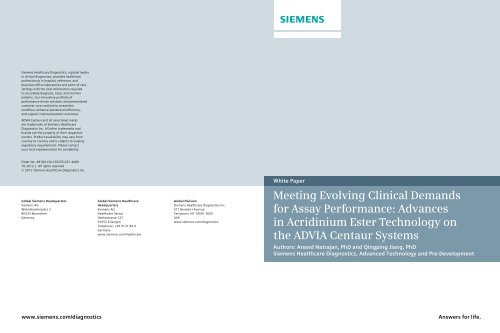

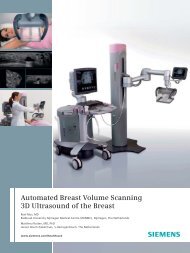
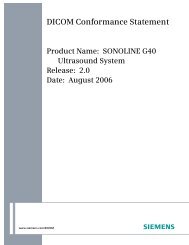
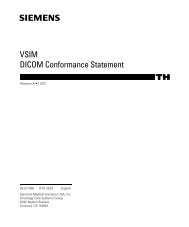

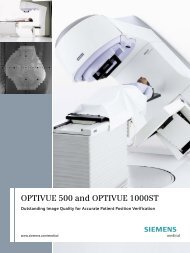
![WalkAway plus Technical Specifications [41 KB] - Siemens Healthcare](https://img.yumpu.com/51018135/1/190x253/walkaway-plus-technical-specifications-41-kb-siemens-healthcare.jpg?quality=85)
